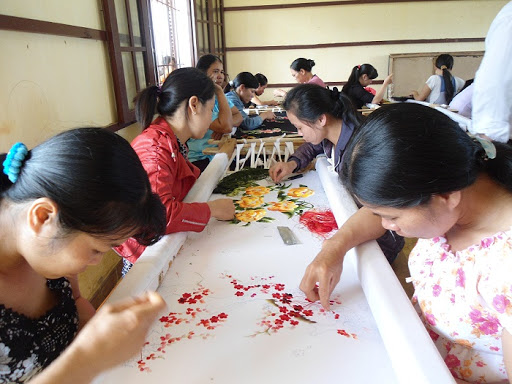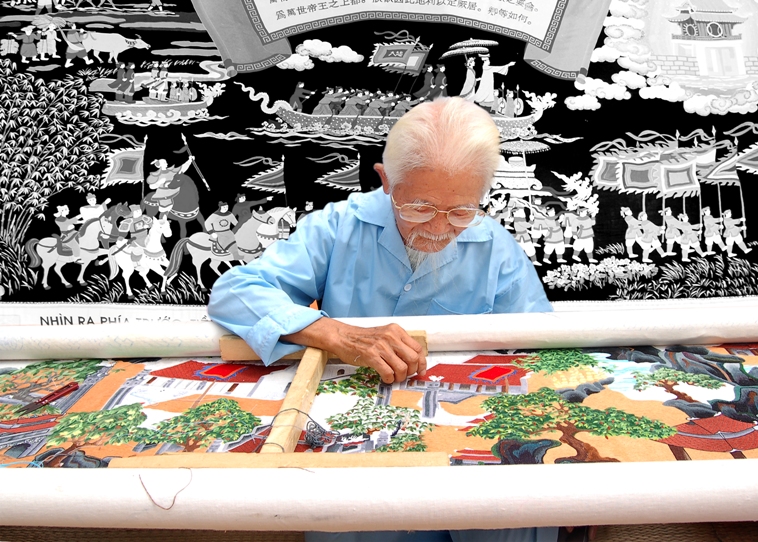No products in the cart.
News
Embroidery in Vietnam
“Man’s work is reading and chanting poems Women’s works is stitching, embroidery and sewing”
Since long ago, embroidery has been considered very close to the women of Vietnam. By providing a meditative space, the rhythmic motions of embroidery bring peace and creativity to skilled artisans. They listen closely to their inner wisdom while the vibrant and intricate patterns of their needlework form beautiful scenes of tranquility. The long history of Vietnamese embroidery dates back to around the 1st century BC, when women would embroider small letters and owes on hand-woven cotton towels. This tradition, which is called “Bach Diep,” steadily developed into an art form under the Ly-Tran dynasties until the 17th century. The appearance of relief embroidery taught by Le Cong Hanh at that time led history to regard him as the patriarch of Vietnamese embroidery. Relief embroidery originated in China and was modified by local traditions and influenced by regional variations in techniques. Up to the early 20th century, the rened embroidery of Vietnam was highly regarded by the royal family in Hue. Furthermore, the colonial lace technique introduced by the French was combined with relief embroidery to produce a unique quintessence of Asian European fashion, incorporating owing designs that created an enigmatic fascination and stirred the heart. Coming to “the kingdom of embroidery with lace” in Van Lam village, Ninh Hai commune, in the Hoa Luu district of Ninh Binh province, you will have a chance to see excellent works of embroidery that are breathtaking.
For Van Lam villagers, embroidery is considered a long-standing tradition. All villagers, regardless of age and gender, do intricate needle work. Visitors will forever remember the image of a young girl sitting next to her great-grandmother, being taught skills handed down for generations in exactly the same manner, amidst the fragrance of rice fields gently waving in the afternoon breeze.
The art of embroidery is taught with- in the family; a potential daughter-in- law wooed from a neighboring village will soon learn the same skills taught only in this quiet village. To the on- looker, it may seem to be simple or relaxing work because there is no laboring under the hot sun, or being subject to the torrential downpours of a seasonal shower. However, this work requires an extremely skillful and steady hand, an eye for the most intricate details, a demanding concentration, and a thorough commitment to producing only the highest quality.
In order to successfully complete a de- tailed and intricate scene, the embroiderer must first capture the image she wishes to convey, whether it be sitting quietly to observe the sun setting over a forest lake, or examining an artist’s rendition of a moment in time. Next she must stretch and test the fabric, inspecting the weave for imperfections or discoloration. Then she will make a detailed sketch on the fabric and select the perfect thread colors to convey the colors to convey the girl sitting next to her great-grandmother, being taught skills.
Once the needle work begins, her most time consuming challenge is to form gently curving edge lines while presenting the most intricate and minute details, such as the veins of a leaf, the early morning shades within the cusp of a owner, or the re in the eyes of a rising phoenix. In order to do so successfully, the embroiderer must combine and mingle the chosen threads with a steady hand for hours on end. She must focus on the harmony of nature to capture a frozen moment of life by means of the needle she has been well acquainted with since child- hood, and using the same skills she had been taught by former generations…
Inspired by Vietnamese embroidery which he much admired, a French buyer exclaimed “L’art dans toute sa grandeur brave” Yes, Art is in all its transcendence!
HOME OF EMBROIDERY
Legend has it that the land of Quat Dong, Thuong Van Lam Tin, Hanoi, is the origin of embroidery with the founder being Le Cong Hanh. To the people of Quat Dong, embroidery is their life. Next to their windows, young Quat Dong women focus passionately on their work with needle and threads. Their skillful hands seem to dance on the fabric, creating lively green paddy fields, floating boats glowing in the moonlight, or on a winter after – noon by Guom Lake. Quat Dong products are diverse, from embroidery pictures, scarves, to bags, clothes, blankets and many more.
Kingdom OF EMBROIDERY- VAN LAM
Located just next to the tourist area of Tam Coc – Bich Dong, the traditional craft village of Van Lam, Ninh Hai Commune, Hoa Lu District, Ninh Binh, is known as a kingdom of embroidery. According to the village’s elders, the embroidery work in Van Lam began more than 700 hundred years. Only with fragile threads, fabrics with many different colors, and skillful hands, creative minds, can Van Lam artisans create sophisticated products with elegant and live patterns. This place has produced many products such as bed sheets, curtains, napkins, handkerchiefs and pictures.
Source: en.vietrade.gov.vn


